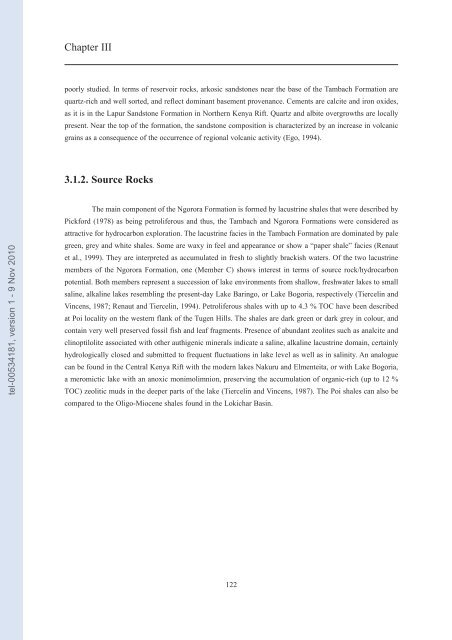Etude stratigraphique, pétrographique et diagénétique des grès d ...
Etude stratigraphique, pétrographique et diagénétique des grès d ...
Etude stratigraphique, pétrographique et diagénétique des grès d ...
Create successful ePaper yourself
Turn your PDF publications into a flip-book with our unique Google optimized e-Paper software.
tel-00534181, version 1 - 9 Nov 2010<br />
Chapter III<br />
poorly studied. In terms of reservoir rocks, arkosic sandstones near the base of the Tambach Formation are<br />
quartz-rich and well sorted, and reflect dominant basement provenance. Cements are calcite and iron oxi<strong>des</strong>,<br />
as it is in the Lapur Sandstone Formation in Northern Kenya Rift. Quartz and albite overgrowths are locally<br />
present. Near the top of the formation, the sandstone composition is characterized by an increase in volcanic<br />
grains as a consequence of the occurrence of regional volcanic activity (Ego, 1994).<br />
3.1.2. Source Rocks<br />
The main component of the Ngorora Formation is formed by lacustrine shales that were <strong>des</strong>cribed by<br />
Pickford (1978) as being p<strong>et</strong>roliferous and thus, the Tambach and Ngorora Formations were considered as<br />
attractive for hydrocarbon exploration. The lacustrine facies in the Tambach Formation are dominated by pale<br />
green, grey and white shales. Some are waxy in feel and appearance or show a “paper shale” facies (Renaut<br />
<strong>et</strong> al., 1999). They are interpr<strong>et</strong>ed as accumulated in fresh to slightly brackish waters. Of the two lacustrine<br />
members of the Ngorora Formation, one (Member C) shows interest in terms of source rock/hydrocarbon<br />
potential. Both members represent a succession of lake environments from shallow, freshwater lakes to small<br />
saline, alkaline lakes resembling the present-day Lake Baringo, or Lake Bogoria, respectively (Tiercelin and<br />
Vincens, 1987; Renaut and Tiercelin, 1994). P<strong>et</strong>roliferous shales with up to 4.3 % TOC have been <strong>des</strong>cribed<br />
at Poi locality on the western flank of the Tugen Hills. The shales are dark green or dark grey in colour, and<br />
contain very well preserved fossil fish and leaf fragments. Presence of abundant zeolites such as analcite and<br />
clinoptilolite associated with other authigenic minerals indicate a saline, alkaline lacustrine domain, certainly<br />
hydrologically closed and submitted to frequent fluctuations in lake level as well as in salinity. An analogue<br />
can be found in the Central Kenya Rift with the modern lakes Nakuru and Elmenteita, or with Lake Bogoria,<br />
a meromictic lake with an anoxic monimolimnion, preserving the accumulation of organic-rich (up to 12 %<br />
TOC) zeolitic muds in the deeper parts of the lake (Tiercelin and Vincens, 1987). The Poi shales can also be<br />
compared to the Oligo-Miocene shales found in the Lokichar Basin.<br />
122

















